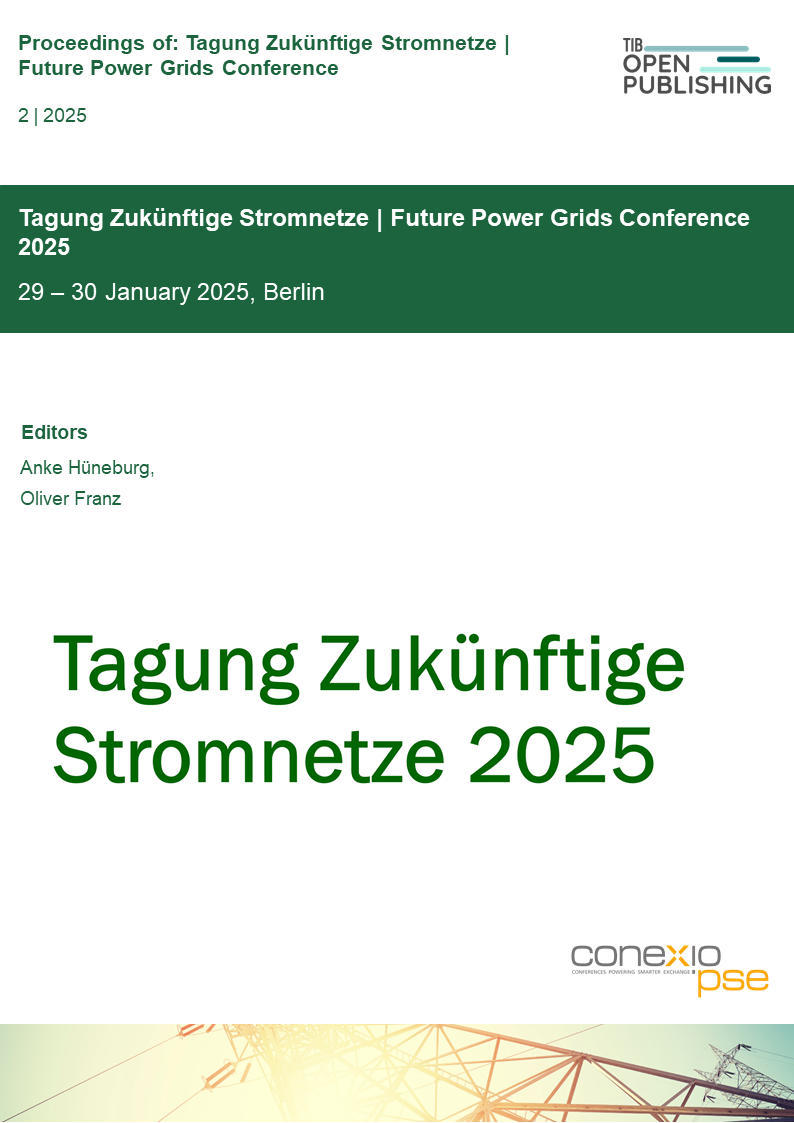Curative System Operation in the 110 kV Distribution Grid
Opportunities for Unlocking and Using the Potential for Higher Utilization
DOI:
https://doi.org/10.52825/zukunftsnetz.v2i.2577Keywords:
Distribution Grid, Curative System Operation, Congestion Management, High Voltage LevelAbstract
The energy transition poses significant challenges for the electrical distribution grid. This paper examines curative system operation in the 110 kV distribution grid that aims to tackle some of these challenges. Unlike preventive system operation, which avoids potential violations of operating thresholds during normal operation before they occur, curative system operation aims to maintain the grid within permissible thresholds only after a critical event through prepared, targeted measures. This paper analyses the complex requirements and challenges in implementing curative measures, particularly in comparison to existing approaches and concerning the high node density and the multitude of possible measures involving renewable generation plants and other customer facilities in the high-voltage distribution grid. By defining relevant thresholds and considering influencing factors, a unified understanding of curative system operation in the distribution grid is established. The paper demonstrates how curative system operation approaches can contribute to ensuring system security and describes the advantages of their utilization. Finally, perspectives for future research in the area of curative system operation in the 110 kV distribution grid are outlined.
Downloads
References
50Hertz Transmission GmbH, Amprion GmbH, TenneT TSO GmbH, and TransnetBW GmbH, “Deutsches Grenzwertkonzept - Regeln zur Ermittlung und Überwachung von Grenzwerten für die Systemführung des deutschen Übertragungsnetzes,” Nov. 2021.
D. Mende, Modellierung von Maßnahmen der Leistungsflusssteuerung in einer nichtline-aren mathematischen Optimierung zur Anwendung im operativen Engpassmanagement elektrischer Energieversorgungssysteme: Zugl.: Hannover, Univ., Diss., 2021. Stuttgart: Fraunhofer Verlag, 2022. [Online]. Available: https://doi.org/10.24406/publica-fhg-416660
A. Monticelli, M. V. F. Pereira, and S. Granville, “Security-Constrained Optimal Power Flow with Post-Contingency Corrective Rescheduling,” IEEE Transactions on Power Systems, vol. 2, no. 1, pp. 175–180, 1987, doi: 10.1109/TPWRS.1987.4335095.
F. Capitanescu and L. Wehenkel, “Improving the Statement of the Corrective Security-Constrained Optimal Power-Flow Problem,” IEEE Transactions on Power Systems, vol. 22, no. 2, pp. 887–889, 2007, doi: 10.1109/TPWRS.2007.894850.
F. Capitanescu et al., “State-of-the-art, challenges, and future trends in security con-strained optimal power flow,” Electric Power Systems Research, vol. 81, no. 8, pp. 1731–1741, 2011, doi: 10.1016/j.epsr.2011.04.003.
D. Westermann et al., “Curative actions in the power system operation to 2030,” in Inter-national ETG-Congress 2019; ETG Symposium, 2019, pp. 1–6.
T. van Leeuwen, A.-K. Meinerzhagen, A. Roehder, and S. Raths, “Integration kurativer Maßnahmen in das Engpassmanagement im deutschen Übertragungsnetz,” 16. Sym-posium Energieinnovation, 2020, [Online]. Available: https://www.tugraz.at/fileadmin/user_upload/tugrazExternal/4778f047-2e50-4e9e-b72d-e5af373f95a4/files/kf/Session_C6/365_KF_vanLeeuwen.pdf
M. Lindner et al., “Corrective Congestion Management in Transmission Grids Using Fast-Responding Generation, Load and Storage,” in 2021 IEEE Electrical Power and Energy Conference (EPEC), Toronto, ON, Canada: IEEE, Oct. 2021, pp. 1–6. doi: 10.1109/EPEC52095.2021.9621491.
F. Klein-Helmkamp, I. Zettl, F. Schmidtke, L. Ortmann, and A. Ulbig, “Hierarchical pro-vision of distribution grid flexibility with online feedback optimization,” Electric Power Systems Research, vol. 234, p. 110779, 2024, doi: 10.1016/j.epsr.2024.110779.
A. Lukaschik et al., “Innovationen in der Systemführung bis 2030: Abschlussbericht: Er-stellt durch die Projektpartner.” 2022. [Online]. Available: https://www.innosys2030.de/wp-content/uploads/InnoSys2030_Abschlussbericht.pdf
European Commission, “COMMISSION REGULATION (EU) 2017/1485 of 2 August 2017 establishing a guideline on electricity transmission system operation: 2017/1485,” Official Journal of the European Union, no. L 220/1. 2021. [Online]. Available: https://eur-lex.europa.eu/legal-content/EN/TXT/PDF/?uri=CELEX:02017R1485-20210315&from=EN
M. Jösting, “Entwicklung von Pilotierungskonzepten kurativer Maßnahmen und Bewer-tung der Anwendbarkeit in der 110 kV-Verteilnetzebene,” Masterarbeit, RWTH Aachen University, Aachen, 2023.
Y. Cong, P. Regulski, P. Wall, M. Osborne, and V. Terzija, “On the Use of Dynamic Thermal-Line Ratings for Improving Operational Tripping Schemes,” IEEE Trans. Power Delivery, vol. 31, no. 4, pp. 1891–1900, Aug. 2016, doi: 10.1109/TPWRD.2015.2502999.
A. Wright and C. Christopoulos, Electrical Power System Protection. Boston, MA: Springer US, 1993. doi: 10.1007/978-1-4615-3072-5.
K. Kollenda et al., “Curative measures identification in congestion management exploit-ing temporary admissible thermal loading of overhead lines,” IET Generation Trans & Dist, vol. 16, no. 16, pp. 3171–3183, Aug. 2022, doi: 10.1049/gtd2.12512.
“Netztransparenz > Ancillary Services > System operations > Redispatch.” Accessed: Mar. 23, 2025. [Online]. Available: https://www.netztransparenz.de/en/Ancillary-Services/System-operations/Redispatch
I. Weber, H. Linka, D. Mertens, T. Muryshkin, H. Opgenoorth, and S. Langer, “FhGenie: A Custom, Confidentiality-preserving Chat AI for Corporate and Scientific Use.” Feb. 29, 2024. [Online]. Available: http://arxiv.org/pdf/2403.00039
Published
How to Cite
Conference Proceedings Volume
Section
License
Copyright (c) 2025 Denis Mende, Andrea Schoen, Nils Bornhorst, Johannes Heid, Jan Wiemer, Thomas Fabian, Angela Gamba, Tammo Fleßner, Jonas Derpmann, Kathrin Schaarschmidt, Ananya Kuri, Mathias Duckheim, Jan Henzgen, Stefan Niessen, Sebastian Stermann, Ingo Liere-Netheler, Maximilian Borning, Lukas Holicki

This work is licensed under a Creative Commons Attribution 4.0 International License.
Accepted 2025-03-31
Published 2025-06-11
Funding data
-
Bundesministerium für Wirtschaft und Klimaschutz
Grant numbers 03EI6119
